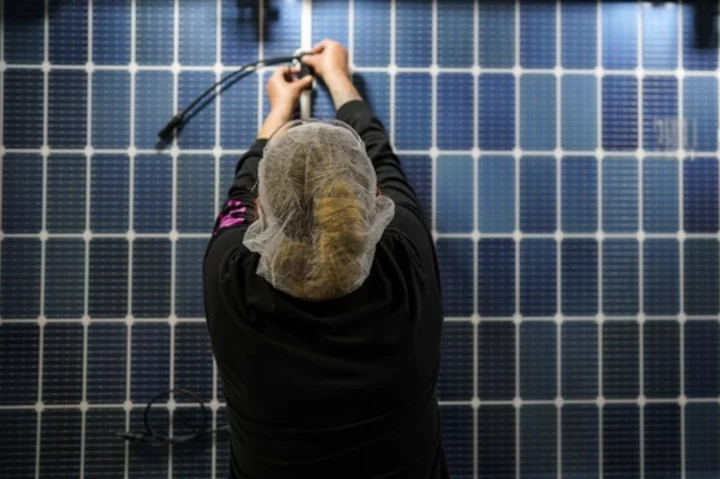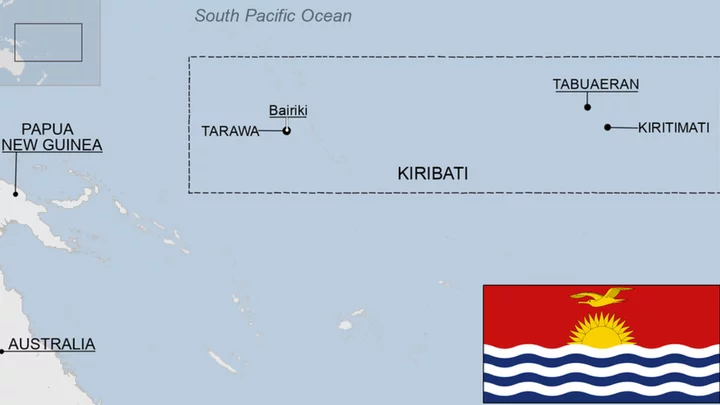
Organigram Provides Corporate Update
TORONTO--(BUSINESS WIRE)--Oct 18, 2023--
1970-01-01 08:00

Rockwell Medical Names Jesse Neri as Senior Vice President, Finance
WIXOM, Mich.--(BUSINESS WIRE)--Oct 18, 2023--
1970-01-01 08:00

Dunkin’® Introduces New Salted Caramel Creamer: Sweet Meets Salty for Your Cup of Coffee at Home
BOSTON--(BUSINESS WIRE)--Oct 18, 2023--
1970-01-01 08:00

Walgreens and the Cardiovascular Research Foundation Unite to Improve Recognition and Diagnosis of Valvular Heart Disease for Older Americans
DEERFIELD, Ill. & NEW YORK--(BUSINESS WIRE)--Oct 18, 2023--
1970-01-01 08:00

Grounded Unveils World’s First 250-Mile Range Electric RV
DETROIT--(BUSINESS WIRE)--Oct 18, 2023--
1970-01-01 08:00

Major solar panel plant opens in US amid backdrop of industry worries about low-priced Asian imports
A South Korean company has begun production at a huge solar panel factory in Georgia
1970-01-01 08:00

Hitting 'snooze' on your alarm might actually be good for you, scientists say
If you’re one of the many people who loves sleep and finds it a huge struggle to get up in the mornings, we’ve got some news that might just make you feel a little better. As it turns out, scientists have released a new study which suggests that hitting snooze on your alarm may actually be good for you. A new study has claimed that the extra sleep brought by snoozing an extra half hour in the mornings could help to improve cognitive performance. The research published in the Journal of Sleep Research surveyed more than 1,700 adults from across the world and looked into their morning habits. According to the study, a total of 69 per cent of those involved admitted they snoozed their alarms at least some of the time. Then, 31 of these people were tested and the researchers found that snoozing their alarms improved some of their scores following cognitive examinations. The tests they were subjected to involved things like memory tests and basic maths questions. Compared to not snoozing for 30 minutes, when the people did snooze they either improved their scores in the tests or their performance was not affected. "Snoozing for 30 minutes in the morning does not have any major negative effects on the sleep that night or how tired one feels when waking up," said Tina Sundelin [via Live Science], who is the lead study author and psychologist at Stockholm University in Sweden. "For those who are drowsy in the morning, such as evening people, and find that snoozing helps them wake up, the study shows that they may actually be more objectively alert [meaning that they performed better on the cognitive tests] after snoozing — even if they don't feel more or less sleepy.” It comes after a sleep expert revealed the worst common sleeping position for people which could be bad for our health. Sign up for our free Indy100 weekly newsletter Have your say in our news democracy. Click the upvote icon at the top of the page to help raise this article through the indy100 rankings
1970-01-01 08:00

China rebukes U.S. over latest chip restrictions
BEIJING China has lodged a stern rebuke of the United States over its latest chip restrictions, China's foreign
1970-01-01 08:00

Britney Spears explains why she shaved her head back in 2007
Britney Spears shocked the world when she shaved her head back in 2007, and now she has revealed why she did it. The then-26-year-old's dramatic makeover made headlines around the world at the time and the images of Spears shaving her head from a Los Angeles hair salon remain an infamous pop culture moment. Now, 16 years on, the 'Baby One More Time' singer has opened up in her new memoir The Woman in Me about how her decision behind the transformation was in response to the tabloid scrutiny she has dealt with from a young age. “I’d been eyeballed so much growing up. I’d been looked up and down, had people telling me what they thought of my body, since I was a teenager,” she told People. “Shaving my head and acting out were my ways of pushing back." From 2008, Spears was under a court-mandated conservatorship which her father Jamie Spears was in charge of and this meant the pop star didn't have control over certain matters in her life such as her personal and financial affairs. “Under the conservatorship I was made to understand that those days were now over,” she wrote. “I had to grow my hair out and get back into shape. I had to go to bed early and take whatever medication they told me to take.” Spears was under the conservatorship for 13 years. Jamie was removed as her conservator in September 2021 before it was completely lifted in November 2021, following the singer's plea to a judge to end the ruling as she declared: "I want my life back." In celebration of the conservatorship ending, Spears was pictured holding a glass of champagne and in the post wrote: "I’m celebrating my freedom and my B day for the next two months." “I mean after 13 years…I think I’ve waited long enough. I’m so happy my lawyer Mathew Rosengart came into my life when he did… he has truly turned my life around… I’m forever thankful for that.” Elsewhere, the 41-year-old also claimed in her memoir that she fell pregnant during her three-year relationship with fellow superstar Justin Timberlake. Sign up to our free Indy100 weekly newsletter Have your say in our news democracy. Click the upvote icon at the top of the page to help raise this article through the indy100 rankings
1970-01-01 08:00

Kiribati country profile
Provides an overview of Kiribati, including key dates and facts about this Pacific island country.
1970-01-01 08:00

Auquan Raises $3.5M to Accelerate Generative AI for Financial Services, Turning Unstructured Data Into Intelligence
LONDON & NEW YORK--(BUSINESS WIRE)--Oct 18, 2023--
1970-01-01 08:00

Experts unravel mystery of the Pokémon episode that hospitalised hundreds of kids
Pokémon’s TV series has been delighting animé lovers for more than 26 years, and yet, there’s one episode that even the most diehard of fans may well have missed. The installment, titled Dennō Senshi Porygon (which roughly translates as "Computer Warrior Porygon”) aired in Japan on December 16, 1997. And, after that single, fateful outing, it was never to grace television screens again. The reason for the ban? Reports of a strange health outbreak among children which was linked to a specific scene. The episode follows Ash Ketchum, Pikachu and their pals as they investigate a faulty Poké Ball transfer machine by getting inside it. Once there, the team come under attack, but are saved when Pikachu unleashes one of his high-octane electric outbursts – represented by a barrage of red and blue strobe lights. And that’s where the trouble began. According to scientific paranormal investigator Benjamin Radford and sociologist Robert Bartholomew, who dedicated a study to the event: "At 6:51 PM, the flashing lights of Pikachu's 'attack' appeared on television screens. “By 7:30 PM, according to Japan's Fire-Defense Agency, 618 children had been taken to hospitals complaining of various symptoms." These symptoms included convulsions, nausea and vomiting, with news of the “illness” spreading rapidly throughout the country. Inevitably, it made headlines, with several news broadcasters replaying the offending clip, “whereupon even more children fell ill and sought medical attention,” Radford and Bartholomew wrote. The following day, TV Tokyo issued an apology, suspended the show, and announced an investigation into the cause of the seizures. Meanwhile, video retailers pulled the series from their shelves, and even the then-prime minister Ryuaro Hashimoto expressed concern at the use of rays and lasers in the popular cartoon. Within two days, the number of children reported to have been affected by the flashing sequence increased to around 12,700. And yet, after four months of investigation – with input from health experts and Japanese government officials – no obvious cause could be found for the outbreak and Pokémon returned to the airwaves. Because, although the bright flashes were assumed to be the cause of the health panic, such visual techniques had been used in numerous other animé episodes before, with no reports of any problems. So what was going on here? Well, a tiny fraction of the children who reported being affected were diagnosed with photosensitive epilepsy, with experts concluding that the rapid colour changes during the scene caused them to suffer seizures. However, the bulk of “patients” reported symptoms that had no identifiable “organic” cause and were, instead, consistent with a very different type of condition… Mass hysteria. Radford and Bartholomew attribute this “epidemic hysteria”, in large part, to the mass media, which they say fuelled panic and misinformation. "Many of the children's symptoms had no identifiable organic basis; other than the verified cases of seizures, the symptoms reported were minor and short-lived; the victims were nearly exclusively school children in early adolescence; and anxiety from dramatic media reports of the first wave of illness reports was evident,” they wrote. “Media reports and publicity fuel the hysteria as news of the affliction spreads, planting the idea or concern in the community while reinforcing and validating the veracity of the illness for the initial victims,” they continued. “According to news accounts of the time, the number of children said to be affected remained around 700 the evening of the Pokémon episode and the next day. “The next morning, the episode dominated the Japanese news. Japanese children who had not heard about their peers from the news or from their parents learned of it that morning when the seizures ‘were the talk of the schoolyards’,” they continued. “Once the children had a chance to hear panicky accounts of what had happened through the mass media, their friends and their schools, the number of children reported the next day to have been initially affected – 2 days earlier – increased by 12,000.” Radford and Bartholomew ended their paper by noting that this Pokémon drama offers a warning to us all. They pointed out that our continuing reliance on mass communications, especially TV and the internet, places us at risk of more and more hysteria outbreaks. “Technological innovations are occurring at unprecedented rates and have the potential to influence significant numbers of people beyond the typical number in traditional mass hysteria episodes,” they stressed. “Epidemic hysterias that in earlier periods were self-limited by geography now have free and wide access to the globe in seconds.” Concluding on an ominous note, they added: “The Pokémon illness symptoms are without precedence, given the large numbers affected, and may be a harbinger of future technological hysterias that have the capacity to affect unprecedented numbers of people at a phenomenal speed.” Sign up for our free Indy100 weekly newsletter Have your say in our news democracy. Click the upvote icon at the top of the page to help raise this article through the indy100 rankings.
1970-01-01 08:00
